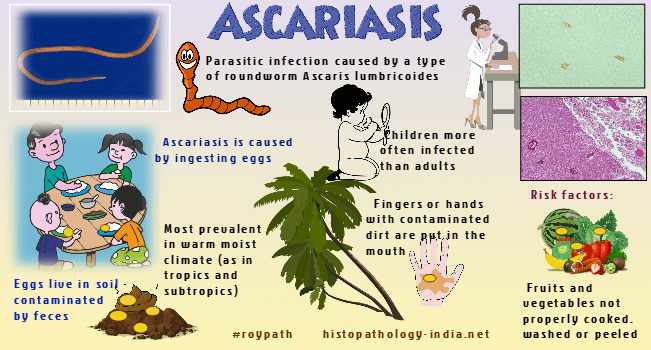|

Custom Search
|
|
Infectious Disease Online Pathology of Ascariasis
|

| Ascaris
lumbricoides is a nematode of worldwide distribution, most prevalent
in tropical and subtropical countries. The incidence and severity of the infection are closely related to hygienic levels. The adult worms range from 15 to 30 cm in length and from 3 to 5 mm in diameter.
Clinical presentation: The patients may often present with a history of passing worms by mouth or anus. A number of patients, presents with a subacute clinical course. Some patients have acute presentation, with severe abdominal pain, fever, dehydration, vomiting, and abdominal distension and may require vigorous fluid resuscitation and emergency surgical intervention. In some cases the adult parasite can invade the biliary or pancreatic ducts and cause obstruction with development of jaundice, cholecystitis, ascending cholangitis, pancreatitis, and hepatic abscesses. A clinical picture resembling bronchial asthma and diffuse peribronchitis, with occasional hemoptysis, is sometimes noted. Physicians should have a high index of suspicion for parasitic infestation in warm climates where economically deprived children present with symptoms of intestinal obstruction. Life Cycle: The eggs are deposited in the soil, where they undergo a period of incubation. The infection is acquired by ingestion of the fully embryonated ova. The larvae are hatched in the small intestine and penetrate the wall, reaching the lungs by way of venules or lymphatics. They pass into the alveoli from the alveolar capillaries and migrate up the main bronchial tree and down the esophagus with swallowed saliva. In the small intestine they grow into adult males or females. Pathological features: Ascaris lumbricoides-induced liver abscess (Dr Y. Tsutsumi) In severe infections, during the period of lung migration, the larvae produce areas of hemorrhage and inflammatory reaction characterized by the presence of neutrophils and eosinophils. Ascariasis is usually a benign and self-limited disease because of the short life span of the adult worm (6 to 12 months). The most frequent complications of ascariasis are caused by the adult parasite. Large masses of worms may produce intestinal obstruction and rarely may lead to perforation and peritonitis. Although ascariasis has been shown to have an adverse effect on nutritional status, there is little evidence that it can cause intestinal malabsorption. Ascaris worms have a tendency to wander into natural passages and may migrate into the biliary system, pancreatic duct or lumen of the appendix. Occasionally the adult worms migrate into the upper respiratory passages.
Diagnosis: Diagnosis is based on faecal examination. Serological tests have been developed but are rarely used for diagnostic purposes. Abdominal roentgenograms, usually show a "whirlpool" pattern of intraluminal worms. Ultrasonography can detect worms in the biliary tract and pancreas and is a useful noninvasive technique for diagnosis and follow-up of such patients. ERCP can help diagnose biliary and pancreatic ascariasis, including ascaris in the duodenum. Also, ERCP can be used to extract worms from the biliary and pancreatic ducts when indicated. Ascaris Suum: (pig roundworm): Closely related to Ascaris lumbricoides and can sometimes infect humans. In humans Ascaris suum develops to the larval tissue - migratory stages and rarely reaches the adult intestinal stage. The true incidence of Ascaris suum infection in humans is unknown.
|
|
|
Copyright © 2022 histopathology-india.net

